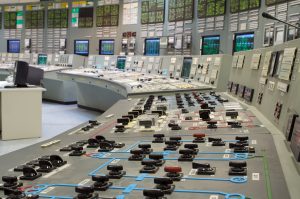The Baltic states have issued a joint boycott of energy produced by the Belarusian nuclear power plant and will require proof that electricity they import in the future isn’t coming from the Russian-built facility.
The move comes at a time of political tumult in Belarus as hundreds of thousands of people take to the streets to demand an end of President Alexander Lukashenko’s 26-year-old reign. Among them have been state workers from the country’s largest industries, including technicians at the new Russian-built nuclear plant.
The plant features two VVER-1200 reactors, built on a $10 billion loan from Rosatom, Russia’s state nuclear corporation. The first reactor was fueled last month and will enter commercial service later this year. Construction of the second reactor is still ongoing but Rosatom says it will be complete by 2022.
The neighboring Baltic states have long been uneasy about the prospect of the Ostrovets- based plant, located only 50 kilometers from Lithuania’s capital. Vilnius has led the charge against buying electricity from the Belarus nuclear plant, outlawing such purchases via a parliamentary vote.
Lithuania’s fears that a nuclear plant located in one of the eastern bloc’s most repressive dictarships is not being built to safety standards and lacks transparency – claims Rosatom has repeatedly denied.
But numerous incidents at the construction site have given Vilnius pause. In 2015, builders at the Ostrovets site made headlines when a crane operator dropped a 330-ton reactor pressure vessel, a sensitive structure that houses the reactor core, from a height of four meters. Minsk sought to cover the incident up, but it was eventually brought to light by a whistleblower.
Another reactor pressure vessel bound for the plant was accidentally run into a cement column when it was being unloaded from a railcar.
As of last week, Estonia and Latvia have joined the Lithuanians in their blockade, both in an effort to deny the Belarus plant their market, and to improve their bargaining position with other energy vendors.
To do so, the three countries have established a single tariff for infrastructure use that will go into effect as soon as the required legal acts have been adopted in Latvia and Lithuania at the end of the first quarter of next year. Estonian laws already allow for the tariff to be established.
Estonian Minister of Economic Affairs and Infrastructure Taavi Aas said the agreement will improve the market position of and prospects of the three states’ electricity producers, World Nuclear News reported.
The agreement is expected to halve electricity trading between the Baltic States and third countries by half. The new agreement will remain in force until the Baltic electricity systems are synchronized in late 2025.
On May 26, Rosatom announced that some 100 workers from the Belarusian plant are currently infected with the coronavirus, though more recent figures haven’t been released.
The Belarusian energy ministry said it plans to add the first reactor, which has a 1.2 gigawatt capacity, to the country’s power system in the fourth quarter of this year.
The ministry said the plant will meet about one-third of Belarus’s demand for electricity, replacing 4.5 billion cubic meters of natural gas per year.








 User Center
User Center My Training Class
My Training Class Feedback
Feedback













Comments
Something to say?
Log in or Sign up for free